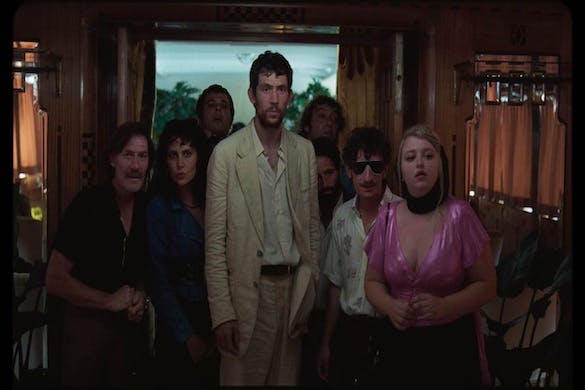Italian Scenery, Curious Characters, Intriguing Themes: ‘La Chimera’ Has It All
The movie is at once a Felliniesque romp set in the ’80s, a poetic ballad in film form, a slyly feminist parable, a caustic commentary on the antiquity art market, a lookbook of distinctly Italian noses, and more.

Lovers of archeology, Italian landscapes, and the faded glamor of old palazzos and staziones should make a date to see the new film “La Chimera,” in theaters starting Friday. Through its tale centering on a band of Etruscan graverobbers, the movie takes viewers into underground tombs, isolated farms, and rustic towns as the group searches for treasure, pleasure, and, for its leader, a reunion with his lost girlfriend.
Merriam-Webster lists three slightly related definitions for the word “chimera,” and each one could be said to describe the picture. The word can mean “an illusion,” which fits with how lead character Arthur keeps dreaming of and pursuing his lost love, Beniamina. It also denotes an entity consisting of different materials, and the movie is at once a Felliniesque romp set in the ’80s, a poetic ballad in film form, a slyly feminist parable, a caustic commentary on the antiquity art market, a lookbook of distinctly Italian noses, and more.
Just as importantly, the word refers to “a fire-breathing she-monster in Greek mythology having a lion’s head, a goat’s body, and a serpent’s tail,” and while the artifacts stolen during the course of the film aren’t Hellenic exactly, the male tomb raiders do carry on like devilish, randy, and brutish but loveable louts.
When we first encounter Arthur, he’s on a train heading back to his makeshift, corrugated iron home situated on the slope of a wooded ridge. He had been doing time for one of his heists and doesn’t want to associate with his crew any longer. Yet his friends prove too irresistible and his desire to keep digging for remnants of the past irrepressible. Soon he’s cavorting with them at a cross-dressing carnival that culminates in a bonfire, and before long searching again for Etruscan goodies using his gift of divining.
Arthur’s talent in finding gravesites with a divining rod isn’t the movie’s sole magical element, for the cinematography beguiles as well — and not just because it captures gorgeous scenery. The imagery’s varying textures, the narrative-enhancing spatial framings, and the occasional audacious, topsy-turvy shot all create a viewing experience both organic and otherworldly. Also adding to the spellbinding atmosphere is an epic folk song sung at times by a troubadour and his triangle player that recounts the group’s misadventures and fortunes, and fills in a bit of our hero’s backstory.
As Arthur, young British actor Josh O’Conner looks somewhat like an ancient Roman bust with his short, slightly curving tufts of hair and strong nose. But we’re told the character hails from England or Ireland, and it’s clear he hasn’t quite mastered the Italian language yet. Helping him in his studies is Beniamina’s mother’s new maid Italia, and a tentative romance develops between them. The problem, though, is that Mr. O’Connor plays the role too morosely, with very little charm beyond his strange intuition, making it hard to believe when Arthur and Italia are suddenly an item.
When it’s revealed that Arthur’s bygone girlfriend is actually deceased and not just “lost,” this viewer began to understand some of Mr. O’Connor’s choices. Still, his chemistry with bright-eyed Brazilian actress Carol Duarte, who plays Italia, doesn’t spark. As Beniamina’s mother, Flora, Isabella Rossellini generates her trademark curious energy, while Vincenzo Nemolato brings quirky humor to the role of Pirro, one of the thieving gang. Even director Alice Rohrwacher’s sister, actress Alba Rohrwacher, joins the collection of characters as a mysterious, ruthless art dealer, and it could be said that this part, too, lends itself to the “mythical female creature” meaning of chimera.
Ms. Rohrwacher, who directed the fantastic “Happy As Lazzaro” a few years ago, addresses the issue of a nation’s stolen cultural heritage often ending up in richer countries, but she’s not overly didactic about it, keeping the movie’s tone light and whimsical. Could she have tightened up her film by trimming the antics of her merry band of plunderers? Sure. With the time saved via this cutting, could she have dug deeper into Arthur’s Orpheus-like quest to be with his beloved again? Definitely.
Ultimately, though, “La Chimera” enchants by reveling in all of its connotations, by threading its story through a gonzo composite form. One won’t soon forget its music, colors, and details, or the moment when Arthur and his acolytes enter a crypt only to discover that it was once a shrine or temple. Arthur’s awe mirrors the viewer’s as we seek answers to what the space and its female statue represent, to why it was hidden away in the dark. Like a theater with a film waiting to be watched.

